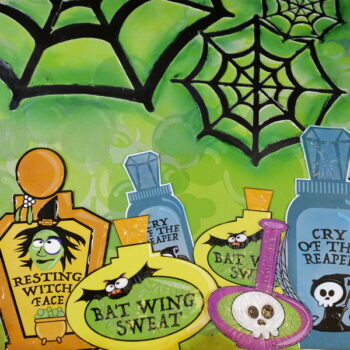
Using Fluid Acrylics in the Art Journal
Have you ever used fluid acrylics in your art journal? If you haven’t heard of these beautiful acrylic paints before, I would highly recommend trying them in your art journal. These acrylic paints are highly pigmented and work so well on their own and with other mediums.
Hop-A-Long Studio is reader-supported. When you buy through links on our site, we may earn an affiliate commission at no cost to you. Learn more.
What are Fluid Acrylic Paints?

Fluid acrylic paints are a highly pigmented paint that have the consistency of heavy cream. These paints are much thinner than a heavy body paint that many of us use in our projects. Golden Acrylics isn’t the only maker of this paint. It is available in a variety of brands including Holbein and Liquitex.
What makes these paints so fabulous is the pigment load. These paints have very little fillers, so they deliver beautiful and intense color.
When you use a paint with a higher pigment load, this gives you so many more options. When mixing with water, you can get very intense color washes. If you are tinting mediums, it will give you a more intense color using much less paint.
If you want an even higher flow paint with an ink-like consistency, try high-flow acrylic paint. I love using high flow acrylics because of the intense pigment and their fluid consistency. This makes them fantastic for blending, writing, and adding thin layers of intense color without using much paint.
What Makes Fluid Acrylics Different than Craft Paint?
Craft paints have a fluid consistency as well but are not light fast because they are dye based. Where fluid acrylics have intense pigment color, the dye base of the craft paint will not be as vibrant. You will need to use much more paint to get a similar intensity to the fluid acrylics.
Craft paint can’t be extended as far as fluid acrylics and won’t mix as nicely with mediums. When using mediums, you can only add so much paint before it changes the medium consistency too much. I would recommend fluid and high flow acrylic paints for mixing with mediums.
My Journey with Fluid Acrylics
As with so many artists, I started using fluid acrylics for paint pouring. I love pouring medium and making beautiful, layered paint pouring paintings. For best results with pouring medium, a fluid and high pigmented paint is needed to tint the pouring medium.
I had a lot of fluid paints in my studio left over from paint pouring. As I experimented and tried different projects, I realized how versatile these paints were. They had so many more uses than just tinting mediums!
Using Fluid Acrylics in the Art Journal
In today’s project, I wanted to show you some simple and effective ways to use fluid acrylics in the art journal.
Mixing Fluid Acrylics with Water
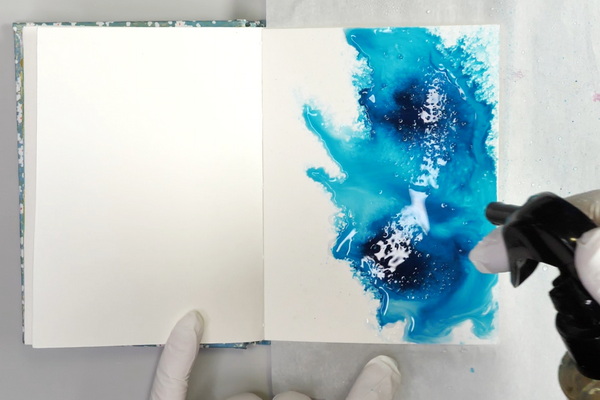
In this project, I wanted to add layers of color onto my art journal page. Using high-flow Turquoise (Phthalo) acrylic paint, I added a few drops to the surface of Strathmore 200 watercolor paper. Using a spray bottle, I spritzed the surface to introduce liquid to the acrylic paint. As the paint is already fluid, it will blend, flow, and move with the water. I pressed the pages of the journal together to spread the paint and create a mirrored image.
Dry the page and repeat the same technique to layer colors. I added layers of Dioxazine Purple, Nickel Azo Gold and Indigo (Anthraquinone) to the page. By adding each color individually and drying it, this allows us to add colors that would not necessarily mix nicely together on the same page. This also creates layers and depth to the page.
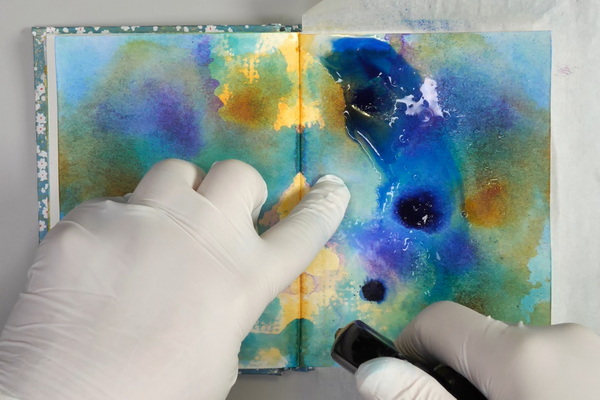
One of the wonderful things about fluid acrylics is once they are dry, the color is set. If you used watercolor paint with this technique the colors would rewet and mix with each layer. This could potentially create muddy colors on your page.
I love this technique because variety of colors that can be used with layers. The surface ends up very smooth and easy to write on, but the colors are fully set.
An Alternative Technique
If you are using colors that do mix well together, you could mix them all at once onto the page. This will create a very different look. You can get some beautiful and unique results by letting the paints mix, as they will flow and create new and unique color mixes.
Writing with Fluid Acrylics
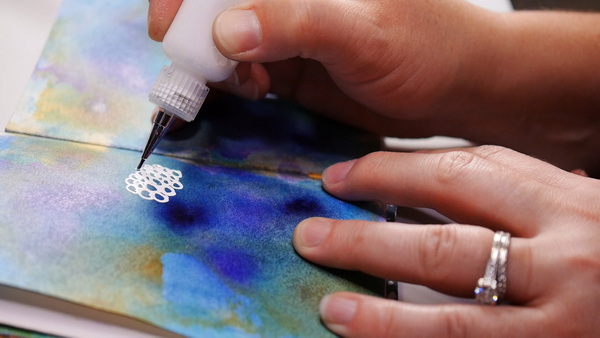
The high flow acrylics work beautifully for writing. If you are using fluid acrylics instead of high flow, add a little bit of water to thin out the paint for writing. When using fluid paint to draw with, use a needle nosed bottle. You could also use a dip pen, refillable acrylic marker or other mark making tools for this step.
Drawing a Flower
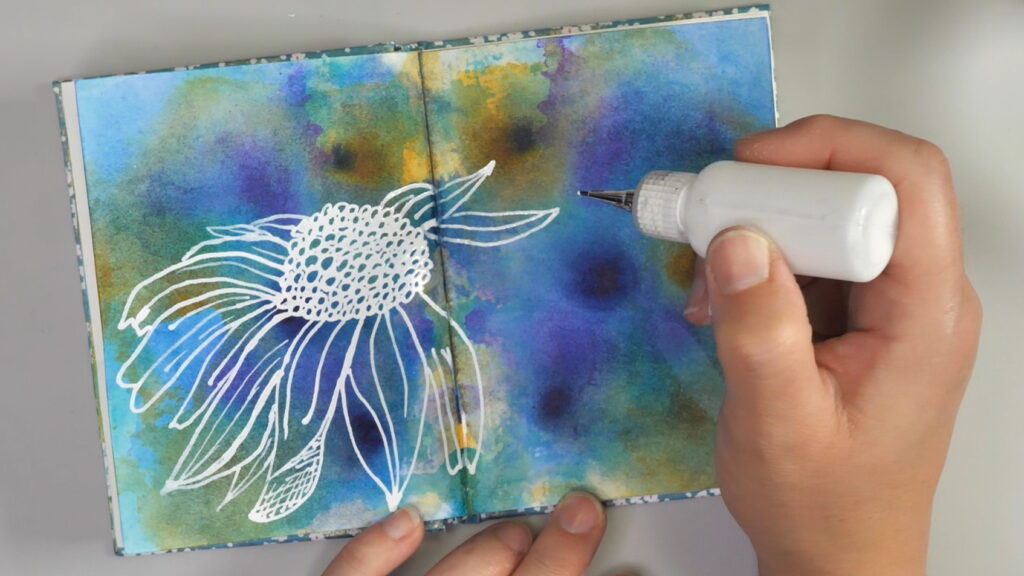
Drawing with fluid acrylics is a much looser technique than writing with a paint pen. I love this technique because it forces me to loosen up my drawing. Because the paint is less controllable, it gives a very different look to your images.
When drawing with a needle nosed bottle, don’t draw too small. The paint will come out thicker than with a paint pen, so to have clear images, they need to be a bit bigger.
For this cone flower drawing, I started by adding a small circles and ovals to create the flower center. Coneflowers have very textured flower centers, so using circles helped create the shape and texture. Continue to add circles until you have the shape and size of flower center that you like.
When drawing petals, the petals start out thin close to the flower center and widen out. They are often overlapped and stick out in a slightly curved direction from the flower. To give a sense of movement and texture, draw the petals and add in texture lines. I also added cross hatching to show the folding of the petals onto each other.
Writing with Fluid Acrylics
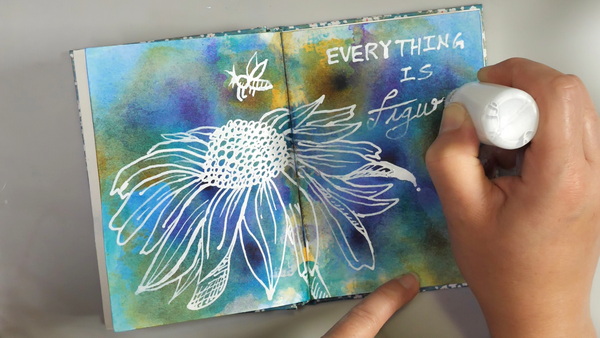
When writing with fluid acrylics, don’t write too small. I like to use capitals and cursive because I find it’s the easiest way to get clear writing on my art journal page. Keep your hand moving to get consistent paint from the bottle and to prevent drops and blobs. With a bit of practice, it’s very easy to get beautiful results with fluid acrylic paints.
Everything is Figure-outable+

As with every journal page I share, I like to include a quote or a thought. Today it is:
“Everything is Figure-outable”
One of my favorite photographers, David DuChemin, often says this. It’s a reminder to me that everything can be figured out. Building a creative habit isn’t always easy, especially at the beginning. There are so many things to learn and so many techniques and possibilities. It can feel overwhelming.
I have also experienced this many times in my journey with blogging, YouTube and art. There are times where I’ve wanted to give up. It feels like too much, like I’ll never figure it out.
But we always have a choice. We can choose to try to figure it out or to give up. But the choice is ours. There are some things that we don’t value or don’t want to spend time figuring out. But everything is figure-outable if we choose to learn.
But sometimes we need help to figure things out. We aren’t always good at everything. We might need to take a course, ask for advice from a friend, or just experiment with things until we build the skill. Everything is figure-outable, the question is do we want to put the time into figuring it out?
This is my challenge to myself, and to you. To remind yourself that you can do it! You have the skills and knowledge to persevere, to learn and to grow. It’s hard and we might want to quit. Sometimes we need to walk away and come back to it. But always remember that you are capable. You can figure it out and you can master anything if you put your mind to it.
Questions?

I hope that this has given you a few ideas on how you can use fluid acrylics in your art journal pages. Fluid acrylics are a great paint that is so versatile, and I hope that you will give it a try in your own art journal! I would love to hear what your experience with fluid acrylics are and how you like to use them in your journal. Please leave a comment below and I’d love to start a conversation with you!
Project Supply List
Homemade Art Journal with Strathmore 200 Paper
Golden High Flow Acrylic Paint Turquoise (Phthalo)
Golden High Flow Acrylic Paint Dioxazine Purple
Golden High Flow Acrylic Paint Nickel Azo Gold
Golden High Flow Acrylic Paint Indigo (Anthraquinone)
Ranger Heat It Craft Tool
Distress Spray Bottle
Parchment Paper
Needle Nosed Bottle



